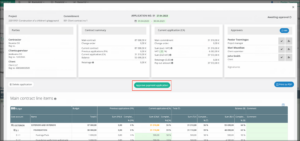Table of Contents
What is cost control in construction?
Cost control in the construction business is all about keeping a close eye on expenses like the cost of materials, paying workers, managing the project, and dealing with any changes that come up during a project to help make more money from it. The goal is to ensure projects finish on time and within the budget, boosting the construction project’s earnings.
Effective project cost control has several key parts. These include making accurate cost predictions, carefully monitoring spending, and quickly dealing with anything that might cause the project to go over budget. To do this, project managers must prepare detailed budgets, set up systems to compare actual costs against the planned budget, and be ready to tweak their cost-handling strategies when necessary.
Another important aspect of construction cost control is ensuring resources like machinery and workers are used on the job site in the best possible way. This also means negotiating good deals and prices with those who supply materials and subcontractors.
Good teamwork and open lines of communication among everyone involved in a project, like architects, builders, engineers, clients, and other key players, are crucial for managing construction project costs effectively.
By working closely and sharing information openly, trust is built, and it becomes easier to make quick, informed decisions. This kind of teamwork and transparency is vital for a project’s success, helping it to meet deadlines and stay within budget.
Importance of cost control in construction
Cost control is vital in the construction sector for boosting profit margins and laying the foundation of a successful business. When a company consistently completes projects on time, within budget, and according to the original plan, it builds a strong reputation. This reliability and better cost control can lead to:
- Securing more contracts in the future
- Improving the success rate of project bids
- Identifying and enhancing existing operational processes
- Staying flexible and responsive to unforeseen obstacles
Beyond preventing budget and cost overruns, effective cost management plays a pivotal role in the overall achievement of a project. It’s based on thorough and precise cost predictions and ongoing monitoring of expenses, fostering a culture of accountability and openness. This transparency helps forge trust and solidify team relationships, proving that in financial dealings, being transparent and honest is always the best approach.
Implementing cost control practices also yields environmental advantages. It encourages efficient use of materials and resources, ensuring that equipment is utilized optimally and the workforce is tailored to the project’s needs. This approach minimizes waste, aligning the cost control process with the broader goal of sustainable and responsible construction practices.
Moreover, construction cost control and project management go hand in hand. Projects that stick to their budgets through effective cost-control procedures and management are more likely to finish on schedule. Proper financial oversight helps avoid delays related to funding issues, unexpected cost increases, or cash flow problems.
Looking at the broader implications, an accurate cost control plan significantly impacts the quality of the finished project. Diligent construction cost management allows investment in critical areas such as safety measures, skilled labor, and high-quality materials. This focus ensures that the project meets and exceeds expectations, highlighting the far-reaching benefits of construction cost control.
How to control costs in a construction project
Cost control in the construction industry is crucial for avoiding cost overruns. Project managers have to do precise cost estimates and create accurate cost control plan for an efficient cost control process. Learn how professional project managers properly conduct cost control with the following steps:
1. Initial Budgeting and Estimation
Right from the start, we join forces with our subcontractors to pinpoint the project’s scope and set clear financial boundaries. This step is crucial for aligning realistic goals and expectations. We calculate a detailed budget by assessing material, labor, and equipment costs alongside anticipating potential risks. Recognizing these risks early on enables us to integrate them into our financial planning effectively. Following this, the proposed budget undergoes a thorough review with all project stakeholders to ensure it is both comprehensive and realistic. Once consensus is achieved, the budget is finalized, laying down a solid financial groundwork for the project and emphasizing efficiency and transparency from the outset.
2. Breakdown of Costs
To manage our project expenses effectively, we systematically categorize every cost. This helps us track and control spending accurately and make informed decisions. Here’s a condensed overview of the cost report:
- Materials: We list all material costs, ensuring we get the best value without compromising quality.
- Labor: We calculate the total labor costs, including wages and any additional benefits or training needed.
- Equipment Hire: We assess the necessity and cost-effectiveness of renting versus leasing equipment.
- Permits: A specific budget is allocated for all required permits and licenses to ensure compliance.
- Contingency Fund: We set aside a safety net to cover unexpected costs, calculating this fund based on the project’s risk level.
This approach gives us a clear picture of our finances, allowing us to adjust the cost plan as needed and keep the project on budget.
3. Implementing Cost Control Software
In our efforts to control project costs tightly, we’ve moved from basic spreadsheets to advanced construction management software. This switch lets us track every expense in real time, ensuring no detail is missed. The software reduces errors and offers detailed reports and forecasts, helping us stay on budget. It’s easy to use and integrates with our other systems, making financial management smoother and more efficient. This modern approach to tracking expenses is a game-changer for us, keeping everyone informed and making sure our projects are financially sound from start to finish.
4. Continuous Expense Monitoring
We’re committed to keeping a tight grip on our project costs. This means constantly checking our spending against our budget plans and quickly fixing any issues we find. Here’s how we do it:
- Use the Latest Software: We track every expense in real-time with advanced software, spotting problems as they happen.
- Spot and Understand Differences: If we spend more or less than expected, we figure out why and adjust our plans.
- Quick Fixes: When costs don’t line up, we act fast to get back on track, talking to our team and renegotiating deals if needed.
- Keep Everyone in the Loop: We make sure everyone involved knows how the budget’s doing, building trust and teamwork.
- Be Ready to Change: Our budget isn’t set in stone. We’re ready to tweak it as the project grows and changes.
This streamlined approach lets us manage our finances closely, ensuring our projects stay on budget from start to finish.
5. Documentation and Clear Communication
Effective financial management in the construction industry hinges on two critical practices:
Detailed Record-Keeping: Using advanced construction management software, we meticulously document every financial detail, from cost estimates to actual costs. This ensures accuracy, facilitates analysis, and supports transparency across the project.
Open Communication: We maintain open lines of communication with subcontractors, material suppliers, and our team, ensuring everyone is informed about the project’s financial status. We keep all stakeholders aligned and engaged through regular updates and digital tools.
Our approach emphasizes the importance of transparency and collaboration, fostering a proactive environment where financial challenges are addressed collectively and efficiently. This commitment to clear communication and detailed documentation is essential for the successful financial management of our projects.
6. Analyzing Variances
Our approach to managing project costs includes a crucial step: cost variance analysis. This process involves:
- Detailed Comparisons: We closely examine the differences between our planned budget and actual spending, checking each area of expense.
- Finding the Causes: It’s important to understand why these variances occur, whether due to unexpected cost increases or other factors. We dig into the details, consulting with our team, subcontractors, and suppliers.
- Solving Problems: Once we know why a variance happened, we take action. This might mean renegotiating costs, adjusting schedules, or finding ways to reduce expenses elsewhere in the project.
- Learning for the Future: Analyzing these variances helps us get better at estimating and planning, reducing surprises in future projects.
- Keeping Projects on Budget: The ultimate goal is to prevent overspending, ensuring we deliver projects within the agreed budget.
This streamlined variance analysis process helps us maintain control over project finances, ensuring the successful and cost-effective completion of our work.
7. Efficient Change Order Management
We handle change orders with a focus on accuracy and efficiency using construction change order software. Here’s how we simplify the process:
- Documentation: Every change is carefully documented, outlining the details, reasons, and cost implications. This clear record keeps everyone aligned and reduces misunderstandings.
- Cost Analysis: We assess the financial impact of each change, considering both direct and indirect costs, to ensure informed decision-making.
- Approval System: Changes undergo a structured approval process by the project manager or us, maintaining control over the project scope and budget.
- Clear Communication: We keep all stakeholders informed about changes, ensuring transparency and collaboration.
- Dispute Avoidance: Our detailed approach minimizes disputes by clarifying expectations and agreements upfront.
This efficient process ensures changes are managed smoothly, keeping projects on track and within budget.
8. Proactive Risk Management and Contingency Planning
Our approach to risk management focuses on being prepared for any surprises:
- Contingency Funds: We set aside part of our budget for unexpected costs, ensuring we’re ready for surprises without straining our finances.
- Continuous Risk Evaluation: We constantly look for new risks, assess their impact, and adjust our plans and budget accordingly.
- Communication: We keep everyone involved in the loop about potential risks and our strategies to handle them, ensuring a collaborative approach to problem-solving.
- Adaptive Strategies: For every risk identified, we craft specific actions to either prevent it or lessen its impact, adapting our tactics as the project evolves.
This streamlined process helps us manage unforeseen challenges efficiently, keeping projects on course and within budget. Read more about contingency planning, if you want comprehensive overview of construction contingency.
9. Efficient Reporting and Financial Management
We streamline our approach to financial oversight and reporting by focusing on key areas:
- Regular Financial Updates: We provide key stakeholders with clear, concise cost reports, comparing actual spending to our budgets and highlighting discrepancies to maintain transparency and trust.
- Cost Efficiency Strategies: By analyzing spending trends and identifying variances, we suggest practical ways to reduce costs without sacrificing quality, ensuring our projects remain financially healthy.
- Proactive Problem-Solving: We tackle financial challenges early, using our reports to spot issues quickly and address them before they escalate, keeping projects on track.
- Future Planning: Our financial analysis extends to forecasting, helping us anticipate future trends and prepare accordingly, ensuring long-term success.
This streamlined process, built on clear communication and proactive financial management, keeps our projects profitable and, on the course, demonstrates our commitment to efficiency, cost estimation, and strategic planning.
For further reading, here is a comprehensive study material for project cost control, monitoring, and accounting and pfd file of construction project cost control.
How to budget with cost control in mind
Budgeting is crucial for completing construction projects successfully. The following cost control techniques help construction managers to budget with increased accuracy.
1. Stay Current with Material Costs
The prices of construction materials are constantly changing, making it more critical than ever to monitor the market closely to remain within your budget. Besides tracking the shifts in prices you’re currently paying, watch the rates offered by the suppliers’ rivals.
Be proactive in negotiating and renegotiating prices, using your existing relationships to secure better deals. Ask for free shipping, bulk buying discounts, or special seasonal rates.
Consider joining a purchasing group to buy materials in bulk at wholesale prices. This approach can help you get better deals based on how much and how often you’re buying, giving you more control over your material costs.
2. Detail Your Construction Budget by Item
Breaking down your project budget into specific items can significantly improve your ability to manage costs. Include the precise costs of materials, labor, overhead costs, and markup percentages for each project phase.
This detailed approach gives you a deep understanding of every project phase, minimizing the risk of overlooking crucial expenses that could diminish your profit. Moreover, having a budget organized into specific items gives you more confidence and control when discussing costs with clients, especially if they have questions about their initial cost estimates.
Whether you provide clients with a detailed line item breakdown or a summarized lump sum quote, clearly understanding the budget’s components is always beneficial for your team.
3. Include Safety Margins and Contingency Funds
Every construction project has its share of unexpected costs, which can affect the final cost and project flow. Challenges such as unexpected price hikes, mistakes in project scope, unfinished designs, adverse weather, and issues with technology or machinery can all lead to increased costs.
Planning ahead by setting aside funds for these unforeseen events is wise, but having a financial safety net within your budget is also crucial. This safety net, known as a full contingency budget, is an extra amount added to your construction estimate to cover unpredictable and uncontrollable events during the project.
Allowances give you leeway in choosing materials or adjusting the project scope at the beginning, while contingencies provide flexibility for dealing with delays, malfunctions, and changes in the economy or market. Incorporating allowances and contingencies in your initial contract and budget can boost your profit margins and better your financial health and fluidity throughout the construction project.
4. Enhance Budget Transparency and Involvement
Opening up budget details to all team members, especially those on the ground, not only keeps everyone aligned with financial goals but also introduces the advantages of what’s known as participative budgeting.
In participative budgeting, lower management levels, like foremen or team leaders, shape the budget rather than just working within set financial limits. This approach has several direct benefits:
- More accurate budget projections for each project phase
- A better understanding of the common hurdles that team leaders encounter
- Additional perspectives to identify oversights or gaps in the budget
- Increased sense of responsibility and ownership among team members
- Strengthened trust between the workforce and management
Participative budgeting can vary in its application, and it’s essential to balance the influx of insights with the efficiency of decision-making processes. The goal is to leverage your team’s collective knowledge to enhance budget accuracy and accountability without hindering project momentum.
5. Move Away from Excel for Construction Budgeting
Using an Excel template for managing construction projects and budgets can be inefficient and risky. Each time the file is downloaded, there’s a chance that outdated figures and information could circulate among team members.
If you’re not using construction management software that prevents downloading separate offline copies, you’re opening the door to potential delays, extra costs, and misunderstandings.
Switching to cloud-based construction management software is a more effective strategy. It ensures your data is updated instantly and enhances the precision and responsibility of your team.
Use Bauwise for construction cost control
The construction cost control process is crucial for completing construction projects successfully. Managing construction costs with Bauwise construction management software is easy because project managers get a real-time overview of project budgets, labor and material costs, future costs, and estimated costs. Effective construction cost management is crucial in the construction industry, and Bauwise cost control software is the best tool on the market to help general contractors improve their cost control methods and get a better overview of construction projects cost details.
About the Author

Mikk Ilumaa
Mikk Ilumaa is the CEO of Bauwise, a leader in construction financial management software with over ten years of experience in the construction software industry. At the helm of Bauwise, Mikk leverages his extensive background in developing construction management solutions to drive innovation and efficiency. His commitment to enhancing the construction process through technology makes him a pivotal figure in the industry, guiding Bauwise toward setting new standards in construction financial management. View profile
Related posts
Read our articles where you can find useful and relevant information about construction cost control:





